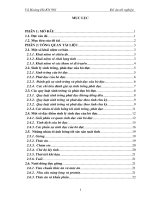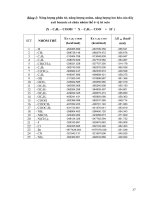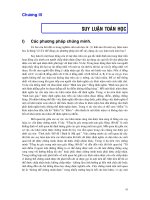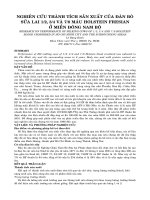Ch 3 4 metamorphic rocks
Bạn đang xem bản rút gọn của tài liệu. Xem và tải ngay bản đầy đủ của tài liệu tại đây (550.59 KB, 13 trang )
Warm Up 10/8
What type of sedimentary rock is formed from weathered particles
of rocks and minerals?
a. intrusive sedimentary rock
c. clastic sedimentary rock
b. chemical sedimentary rock
d. biochemical sedimentary rock
2. What type of rocks are formed by processes powered by the sun?
a. No rocks are formed by energy from the sun.
b. sedimentary rocks
c. igneous rocks
d. metamorphic rocks
3. What type of composition does an igneous rock have that contains
mostly plagioclase feldspar and about 30 percent dark silicate
minerals?
a. ultramafic
c. basaltic
b. andesitic
d. granitic
Answers: 1) c. 2) b. 3) b.
1.
Metamorphic Rocks
Chapter 3, Section 4
Formation of Metamorphic Rocks
Most metamorphic changes occur at elevated
temperatures and pressures. These conditions are
found a few kilometers below Earth’s surface and
extend into the upper mantle.
Contact Metamorphism – hot magma moves into
rocks and changes the rock around it
Regional Metamorphism – occurs during mountain
building as large areas of rock are subjected to
temperature and pressure changes
Regional metamorphism results in large-scale
deformation and high-grade metamorphism
Formation of Metamorphic Rocks
Contact Metamorphism
Regional Metamorphism
Concept Check
Compare and contrast contact and regional
metamorphism.
Both processes change existing rocks into
metamorphic rocks. Contact metamorphism is
caused by magma and often produces slight
changes in rocks. Regional metamorphism is
large-scale deformation that can result in drastic
changes to the rocks involved.
Agents of Metamorphism
The agents of metamorphism are heat, pressure,
temperature, and hydrothermal solutions
The most important agent of metamorphism is heat
and comes from two sources, magma and change of
temperature with depth
Minerals become unstable and recrystallize to form new
minerals
With increased heat and pressure deep in the crust,
rocks will flow instead of fracture
Hot fluids will dissolve old minerals and deposit new
ones, changing the composition of the rock
Agents of Metamorphism
Stress as a
Metamorphic
Agent
Classification of Metamorphic Rocks
The texture of metamorphic rocks can be
foliated or nonfoliated
Foliated Metamorphic Rocks – The
realignment of the minerals, at right angles to
the direction of force, produces a banded
appearance
Nonfoliated Metamorphic Rocks –
metamorphic rocks that does not have a banded
texture and contains only one mineral
Classification of Metamorphic Rocks
Foliated – Gneiss
Nonfoliated – Marble
Concept Check
Contrast foliated and nonfoliated metamorphic
rocks.
Foliated metamorphic rocks have a layered or
banded appearance. Nonfoliated metamorphic
rocks do not have a banded texture.
Assignment
Read Chapter 3, Section 4 (pg. 80-84)
Do Section 3.4 Assessment #1-8 (pg. 84)
Study for Chapter 3 Quiz!









